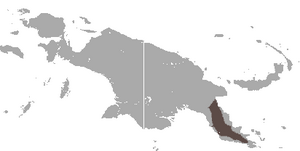Doria's tree-kangaroo facts for kids
Quick facts for kids Doria's tree-kangaroo |
|
|---|---|
 |
|
| Dendrolagus dorianus from New Guinea. Stuffed specimen | |
| Conservation status | |
| Scientific classification | |
| Genus: |
Dendrolagus
|
| Species: |
dorianus
|
 |
|
| Doria's tree-kangaroo range | |
The Doria's tree-kangaroo (Dendrolagus dorianus) is a special type of tree-kangaroo. It lives only in Papua New Guinea. This means it is endemic to that area.
Where They Live
This amazing marsupial lives in the montane forests. These are mountain forests in southeastern New Guinea island. You can find them high up, between 600 and 3,650 meters above sea level.
The species got its name in 1883. Edward Pierson Ramsay named it after an Italian zoologist. His name was Giacomo Doria.
What They Look Like
Doria's tree-kangaroo is one of the biggest tree-kangaroo species. They usually weigh between 6.5 and 14.5 kilograms. Their body length is about 51 to 78 centimeters. They also have a long tail, which is 44 to 66 centimeters.
They have long, thick brown fur. Their ears are black. Their tail is pale brown or cream. This tail is not prehensile, meaning they cannot use it to grab things. They have large, strong claws. Their body is stocky, which makes them look a bit like a bear.
Their Habits
Most Doria's tree-kangaroos live alone. They are also nocturnal, meaning they are active at night.
Their diet includes different leaves, buds, flowers, and fruits. A mother carries her single baby for about 30 days. After birth, the baby stays in its mother's pouch for up to 10 months.
Conservation Status
Doria's tree-kangaroo is listed as a Vulnerable species by the IUCN Red List. This means they are at risk of becoming endangered. Their forest home is shrinking because of logging and forest clearing. Also, because they are large, people sometimes hunt them for their meat.
See also
 In Spanish: Canguro arborícola de Doria para niños
In Spanish: Canguro arborícola de Doria para niños



